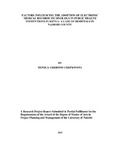| dc.description.abstract | The application of Electronic Medical Records Technology has gained much
prominence and is widely used in Kenyan hospitals today. This technology agitates
for paperless transactions health care. Many studies have been done in other countries
to study the factors influencing adoption and utilisation of EMR technology, but a
small number of studies exist in Kenyan situation. This study sought to examine why
the application of EMR technology has not kept pace with its demand. This study
sought to answer four key research questions derived from the study objectives which
include the influence of resource availability, accessibility to network infrastructure,
capacity building and staff levels of education on the adoption of electronic medical
records technology in public health institutions in Nairobi County. This study was
guided by four hypotheses derived from study objectives. Empirical literature of the
works of widely published scholars was reviewed. The study was guided by diffusion
and technology acceptance model as its theoretical framework. The study adopted
across sectional survey design with a target population of 200 respondents. Using the
Krejcie and Morgan table to determine the sample size, 127 respondents were
sampled for this study. To achieve a desired representation, simple random sampling
was used. A questionnaire with a 5-point Likert scale was constructed and used. The
data obtained was analysed by descriptive statistics using SPSS Version 20.0 and the
findings was appropriated to the research questions. Qualitative data was analysed by
inferential methods and presented descriptively. Both content and construct validity
were used to ensure validity of the research instrument‟s while reliability was
determined by using the Cronbach-Alpha Coefficient. Pilot testing to pre-test and
validate the research instruments was done prior to the main study. Two of the four
hypothesis were rejected, there seemed to exist no significant relationship between
accessibility to network and adoption of EMR technology with (p = 0.836 > 0.05), no
significant relationship between staff level of education and competencies and
adoption of EMR technology with (p = 0.151 > 0.05) and two hypothesis were
accepted, there seemed to exist a significant relationship between resource availability
and adoption of EMR technology with (p = 0.027 < 0.05) and a high significant
relationship between capacity building with adoption and use of EMR in public health
institutions in Nairobi with (p = 0.000 < 0.05). Computed MLR results showed that
the four factors studied accounted for 28.5% of variance with adoption of EMR. The
study recommends that health facilities should increase infrastructure and resources
that support EMR use, employees should be supported for further training on EMR
operation and suppliers should regularly support and training health staff on how to
use EMR usage. The study results may be useful to hospitals as they gear towards
integrating all their process by using technology. | en_US |

